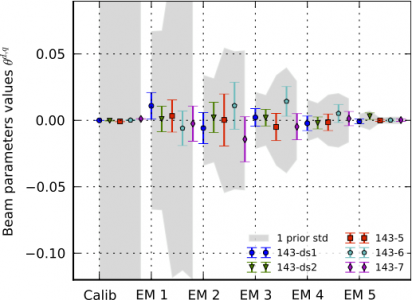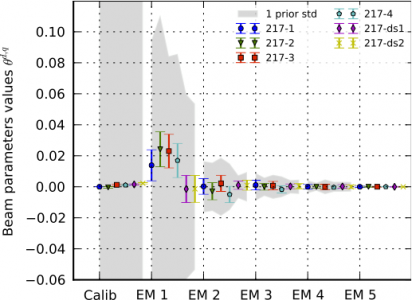Difference between revisions of "Power spectra"
m (Created page with 'This is the page regarding the HFI-based power spectra ! ==Intra-frequency checks== ==Best-fit frequency spectra== ==Inter-frequnecy checks==') |
|||
| (16 intermediate revisions by 4 users not shown) | |||
| Line 1: | Line 1: | ||
| − | This | + | This page describes the HFI based power spectra. |
| − | + | We call intra-frequency checks those performed between detectors (or sets of detectors) in the same frequency bands, which thus respond similarly to the sky emission. Interfrequency-checks on the other hand correspond to checks between detector in different frequency bands, imposing further reliance on a sky model to perform the test. | |
==Intra-frequency checks== | ==Intra-frequency checks== | ||
| + | |||
| + | These compare the power spectra between various detector sets operating within the same frequency channel. They see the same sky, and should therefore give consistent results, up to the noise level, and up to color corrections due to their somewhat different spectral band passes. These corrections are rather small if one restricts the comparison to specific portions of the sky, for instance dominated by extra-Galactic components, like it is done for extracting the CMB power spectrum in the likelihood analysis where $f_{sky} \sim 0.4$. | ||
| − | == | + | <center> |
| + | <gallery widths="500px" heights="300px"> | ||
| + | File:A143.png | 143 GHz detector sets | ||
| + | File:A217.png | 217 GHz detector sets | ||
| + | </gallery> | ||
| + | '''Consistency checks''' | ||
| + | </center> | ||
| − | + | The pictures shows in grey the prior deduced from the beam parameters uncertainty analysis. At 217 GHz, the distance between PSB and SWB suggests an accounted for effect (fortunately small enough for the likelihood analysis). The relative calibration appear to be at the 0.1% level. | |
| + | |||
| + | This shows that whatever systematic effect might remain, it has to be common to all detectors within a frequency band to a very high level of accuracy. | ||
| + | |||
| + | [[Category:HFI data processing|008]] | ||
Latest revision as of 20:54, 17 March 2013
This page describes the HFI based power spectra.
We call intra-frequency checks those performed between detectors (or sets of detectors) in the same frequency bands, which thus respond similarly to the sky emission. Interfrequency-checks on the other hand correspond to checks between detector in different frequency bands, imposing further reliance on a sky model to perform the test.
Intra-frequency checks[edit]
These compare the power spectra between various detector sets operating within the same frequency channel. They see the same sky, and should therefore give consistent results, up to the noise level, and up to color corrections due to their somewhat different spectral band passes. These corrections are rather small if one restricts the comparison to specific portions of the sky, for instance dominated by extra-Galactic components, like it is done for extracting the CMB power spectrum in the likelihood analysis where $f_{sky} \sim 0.4$.
Consistency checks
The pictures shows in grey the prior deduced from the beam parameters uncertainty analysis. At 217 GHz, the distance between PSB and SWB suggests an accounted for effect (fortunately small enough for the likelihood analysis). The relative calibration appear to be at the 0.1% level.
This shows that whatever systematic effect might remain, it has to be common to all detectors within a frequency band to a very high level of accuracy.
(Planck) High Frequency Instrument
Cosmic Microwave background

